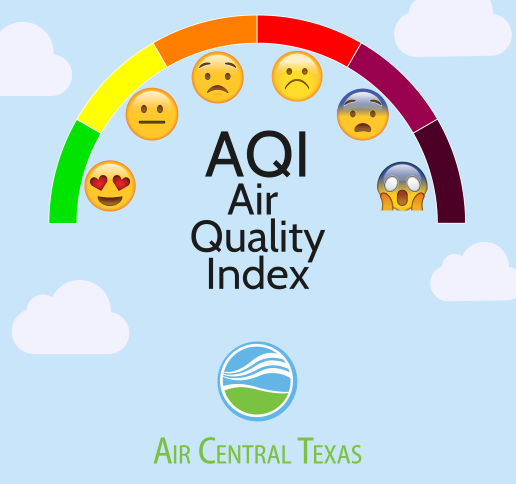Air Quality and Environmental Justice
Clean air is essential to health. Yet nearly half of Americans are still breathing unhealthy air, and the burden is not evenly shared. Some communities are disproportionately impacted by air pollution - those facing the greatest burden are certain communities of color and low-income communities. In fact, people of color are 1.5 times more likely to live in an area with poor air quality than white people, according to the American Lung Association.
Read the American Lung Association's article on "Environmental Justice: Addressing the Burden of Air Pollution" to learn more about what how you can make an impact on environmental justice.
Learn below what the Air Quality Index is so that you can protect yourself and your family from poor air quality.
Austin Environmental Justice History
*excerpt from the draft Austin Climate Equity Plan provided by the City of Austin Office of Sustainability
One of the most damaging chapters of Austin’s history is the 1928 Master Plan, which divided the city along racial lines using a practice called redlining. Redlining forcibly displaced and sectioned off primarily Black and Hispanic/Latinx residents into specific, undesirable areas and was achieved by a combination of cutting off or denying services and white supremacist violence inflicted on any person of color who tried to live elsewhere in the city. Redlined districts were used by financial institutions to decide which neighborhoods they would or would not invest in, making it harder for communities in these areas to get loans. Additionally, deed restrictions and City ordinances often prohibited people of color from buying or renting homes outside of East Austin. Under the 1957 Industrial Development Plan, property in East Austin was zoned as “industrial,” including existing single-family residential areas. This allowed residential homes and schools to be built on industrial-zoned land alongside hazardous and polluting facilities. These burdens were not shared equally among all Austin residents, as this same zoning was not allowed in the western parts of the city. Subsequent planning documents, including the 1984 Land Development Code, perpetuated systemic racism and racial injustice.
Community-based organizations such as PODER (People Organized in Defense of Earth and her Resources), the National Association for the Advancement of Colored People (NAACP) and other Eastside community groups have examined the impact of the City of Austin’s historical land use and planning policies and how they have harmed residents in East Austin. The siting of infrastructure like the Tank Farm fuel storage facility, BFI Recycling Plant and City of Austin’s Holly Power Plant alarmed communities of color, exposed people of color to toxic pollution and threatened the natural environment and vibrant culture in East Austin neighborhoods. Community members and activists have since worked to re-define environmental issues as social and economic justice issues, and collectively aim to frame these concerns as basic human rights issues.
What is the Air Quality Index (AQI)?
Everyday the Air Quality Index (AQI) tells you how clean or polluted your outdoor air is, along with associated health effects that may be of concern. The AQI translates air quality data into numbers and colors that help people understand when to take action to protect their health.
"Sensitive groups" for air pollution include children and teenagers, senior citizens, adults with respiratory or cardiac illnesses, and adults who are active outdoors such as outdoor workers.
See your Current AQI
- At www.airnow.gov
- Through EnviroFlash email alerts
- With the free AirNow App for iPhones and Android
- With the customizable AirNow Widget for your organization
AQI Forecasts
Like the weather, a forecast is created for the AQI for the next few days. You can see the current AQI forecasts at AirNow.gov when you input your location or through the TCEQ to see the forecast for Texas regions. The forecast is helpful so that you can plan accordingly if you're sensitive to poor air quality.

Where's your AQI Coming From?
The U.S. EPA AirNow program is the national repository of real time air quality data and forecasts for the United States. AirNow is the vehicle for providing timely Air Quality Index (AQI) information to the public, media outlets, other federal agencies and their applications, and to the research community. Information that you can find on AirNow includes;
- Year round 24/7 coverage delivers real-time data (ozone & particle pollution) for 50 states, 6 Canadian provinces and 24 U.S. national parks
- Next-day Air Quality Index (AQI) forecasts for over 400 cities in the summer and 300 cities year-round
- State-of-the-science information about air pollution health effects

Guides for Air Pollution
Before you get out and about, visit AirNow.gov to check air pollution levels in your community. This is especially important if someone in your family belongs to a group that is more sensitive to air pollution, such as children, older adults, and those with heart or lung problems.
When ozone or particle pollution levels reach unhealthy levels, you and others in your community can reduce air pollution. Check out the EPA's Guides for Ozone and Particulate Matter Pollution. These guides provide ways to protect your health when pollution reaches unhealthy levels.
- EPA Guide for Particle Pollution
- EPA Guide for Ozone Pollution
- EPA Guide for Schools - This guide provides ways to keep children active while protecting their health when air pollution reaches unhealthy levels.